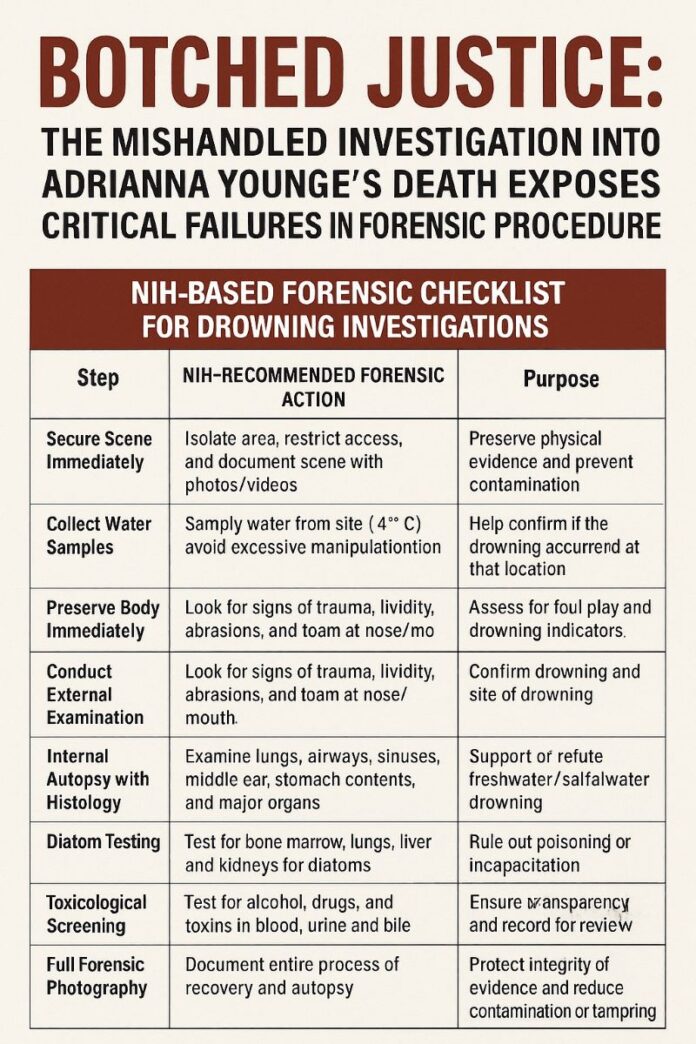The tragic death of 11-year-old Adrianna Younge at the Double Day Hotel in Tuschen, Guyana, has sparked national outrage and raised serious concerns about the handling of the investigation. From the initial search efforts to the autopsy findings, numerous procedural lapses have been identified, leading to widespread calls for transparency and justice.
A Timeline of Events
On April 23, 2025, Adrianna visited the Double Day Hotel with her grandmother and other relatives. She was last seen near the hotel pool shortly after 1:00 PM. When she failed to return, her family initiated a search and reported her missing to the Tuschen Police Station around 3:30 PM. Despite searches, her body was discovered floating in the hotel pool nearly 20 hours later, around 10:00 AM on April 24.
Investigation Missteps
Initial Police Response
The Guyana Police Force initially reported that surveillance footage showed Adrianna entering a red and black Toyota Raum, suggesting she had left the premises. This information was later retracted, with the police acknowledging the error and launching an internal investigation into the misinformation.
Crime Scene Management
Concerns have been raised about the handling of the potential crime scene. Questions remain about whether the pool area was properly secured and whether evidence was preserved adequately during the initial search and after the discovery of Adrianna’s body. The lack of immediate cordoning off of the area may have compromised critical evidence.
Autopsy Findings
A forensic autopsy conducted by a team of pathologists, including experts from the U.S. and Barbados, concluded that Adrianna died by drowning. No signs of sexual assault, violence, or broken bones were found. However, due to the advanced state of decomposition, the exact time and circumstances of death could not be determined.
Notably, the autopsy did not include an analysis of bodily fluids or water from the pool, which are critical in determining the presence of foreign substances or confirming the drowning medium. According to the National Institutes of Health, such analyses are essential in drowning cases to distinguish between freshwater and saltwater drowning and to detect possible toxins.
Public Outcry and Government Response
The perceived mishandling of the case led to widespread protests across Guyana. Demonstrators clashed with police, resulting in the imposition of an overnight curfew. President Irfaan Ali met with Adrianna’s family, pledging full support for an independent investigation and promising that no resources would be spared in uncovering the truth.
In response to the public outcry, Assistant Commissioner of Police Khalid Mandall was reassigned, and a special investigative team was established to oversee the case.
Procedural Imperatives for Thorough Investigation
The NIH article titled “Drowning: A Review of Epidemiology, Pathophysiology, Treatment, and Prevention“ (PMCID: PMC6474464) emphasizes several critical forensic procedures that were either insufficiently followed or entirely absent in the case of Adrianna Younge:
1. Fluid Analysis from Lungs and Body Cavities
According to the NIH article, quantitative and qualitative analysis of lung fluid and pleural cavity contents can be crucial in confirming drowning as a cause of death. It also suggests that comparative analysis with the drowning medium (e.g., pool water) can identify whether the water in the lungs matches the suspected source, an important step absent in Adrianna’s autopsy.
“Measurement of electrolyte concentrations (especially sodium and chloride) in the serum and comparison with that in the aspirated water can help differentiate drowning from postmortem immersion.” — NIH, PMC6474464
Yet, in Adrianna’s case, no water samples were reportedly collected from the hotel pool, nor were bodily fluids preserved or analyzed to verify this correlation.
2. Postmortem Diatom Test
The NIH outlines that the presence of diatoms (microscopic algae) in lung tissue and internal organs can be used to support a diagnosis of drowning. Their distribution can distinguish between antemortem and postmortem immersion.
“The detection of diatoms in internal organs has been used as corroborative evidence of drowning… However, the test should be interpreted carefully due to possible contamination.”
There is no indication that diatom testing was performed in Adrianna’s case, a missed opportunity for confirmatory evidence.
3. Thorough Scene and Environmental Analysis
The NIH also stresses the need for immediate scene evaluation and documentation, including:
- Securing the area to prevent contamination.
- Testing of water pH, temperature, and microbial content.
- Collection of clothing and debris from the water.
“Environmental assessment is essential in suspected drowning to determine potential contributing factors, including water quality, hazards, and the presence of toxins.”
In the Younge case, the scene was not promptly sealed, and environmental testing including collection of pool water or assessment of pool safety measures was apparently not conducted.
4. Preservation of the Body for Forensic Evaluation
Prompt refrigeration and minimal manipulation of the body are vital in cases of potential drowning. This preserves tissue for accurate histological analysis, which deteriorates rapidly after death in water environments.
There has been no confirmation that the body was refrigerated or otherwise preserved correctly, especially as reports noted advanced decomposition only 20 hours after Adrianna went missing, potentially from prolonged exposure.
Summary:
The NIH’s recommended forensic protocols, if followed, could have clarified the circumstances of Adrianna’s death. Their omission, particularly regarding fluid sampling, diatom testing, and environmental forensics, underscores the systemic shortcomings in the case’s handling.
✅ NIH-Based Forensic Checklist for Drowning Investigations
| Step | NIH-Recommended Forensic Action | Purpose |
| 1. Secure Scene Immediately | Isolate the area, restrict access, and document the scene with photos/videos | Preserve physical evidence and prevent contamination |
| 2. Collect Water Samples | Sample water from site (pool, river, etc.) for comparison with fluid in lungs and stomach | Helps confirm if drowning occurred at that location |
| 3. Preserve Body Immediately | Store body in refrigeration (4°C) and avoid excessive manipulation | Prevent decomposition, especially in warm/humid environments |
| 4. Conduct External Examination | Look for signs of trauma, lividity, abrasions, and foam at nose/mouth | Assess for foul play and drowning indicators |
| 5. Internal Autopsy with Histology | Examine lungs, airways, sinuses, middle ear, stomach contents, and major organs | Determine antemortem vs postmortem changes |
| 6. Diatom Testing | Test bone marrow, lungs, liver, and kidneys for diatoms | Confirms drowning and site of drowning (match diatoms with site water) |
| 7. Toxicological Screening | Test for alcohol, drugs, and toxins in blood, urine, and bile | Rule out poisoning or incapacitation |
| 8. Electrolyte Analysis | Measure chloride and sodium levels in blood and compare with drowning medium | Supports or refutes freshwater/saltwater drowning |
| 9. Full Forensic Photography | Document entire process of recovery and autopsy | Ensures transparency and record for review |
| 10. Chain of Custody Documentation | Maintain strict documentation of who handles the body and when | Protects integrity of evidence and reduces contamination or tampering |
❌ Application to the Adrianna Younge Case
| Step | NIH Standard | Case Status |
| 1. Scene Security | Should be immediate | No evidence of prompt sealing; body found 20 hours later |
| 2. Water Sample Collection | Critical for comparison | Not conducted or reported |
| 3. Body Preservation | Vital to slow decomposition | Body showed advanced decomposition after 20 hours—unclear if preserved |
| 4. External Examination | Standard forensic step | No signs of trauma reported; but decomposition may have obscured evidence |
| 5. Internal Autopsy | Performed | ✔ Conducted, but lacked associated water testing |
| 6. Diatom Testing | Strongly recommended | ❌ Not performed or mentioned |
| 7. Toxicology | Essential | ❌ No toxicology results publicly disclosed |
| 8. Electrolyte Testing | To verify drowning medium | ❌ No such analysis reported |
| 9. Forensic Photography | Required for documentation | ❌ No public confirmation this was done |
| 10. Chain of Custody | Critical step | ❌ No documentation disclosed; body moved between locations |
Conclusion
The investigative handling of Adrianna Younge’s death missed multiple critical forensic steps recommended in drowning cases. The absence of environmental sampling, fluid analysis, diatom testing, and toxicology deeply undermines confidence in the drowning conclusion. These failures have compromised the investigation’s scientific integrity, left significant questions unanswered, and eroded public trust. As the nation mourns, there is a collective demand for accountability, transparency, and systemic reform to ensure that justice is served and similar tragedies are prevented in the future.






